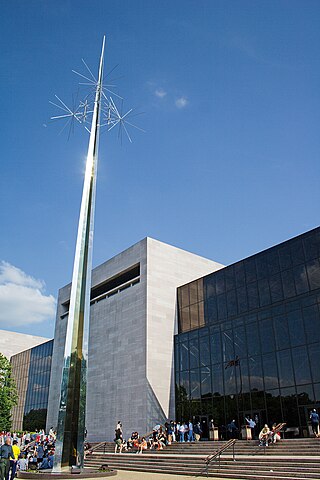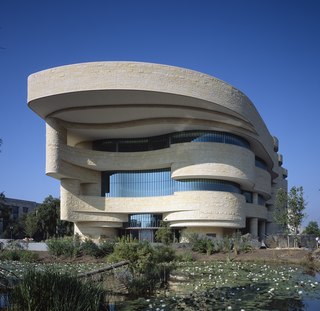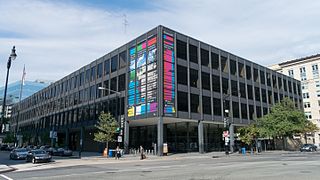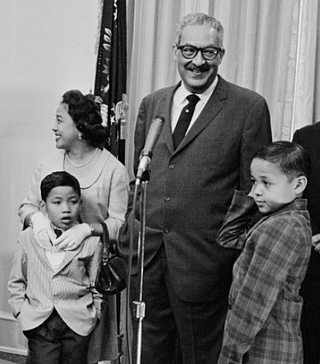Related Research Articles

The Smithsonian Institution, or simply the Smithsonian, is a group of museums, education and research centers, the largest such complex in the world, created by the U.S. government "for the increase and diffusion of knowledge." Founded on August 10, 1846, it operates as a trust instrumentality and is not formally a part of any of the three branches of the federal government. The institution is named after its founding donor, British scientist James Smithson. It was originally organized as the United States National Museum, but that name ceased to exist administratively in 1967.

The NAMES Project AIDS Memorial Quilt, often abbreviated to AIDS Memorial Quilt or AIDS Quilt, is a memorial to celebrate the lives of people who have died of AIDS-related causes. Weighing an estimated 54 tons, it is the largest piece of community folk art in the world as of 2020. It was conceived in 1985, during the early years of the AIDS pandemic, when social stigma prevented many AIDS victims from receiving funerals. It has been displayed on the Mall in Washington, D.C., several times. In 2020, it returned to the AIDS Memorial in San Francisco, and can also be seen virtually.

The National Mall is a landscaped park near the downtown area of Washington, D.C., the capital city of the United States. It contains and borders a number of museums of the Smithsonian Institution, art galleries, cultural institutions, and various memorials, sculptures, and statues. It is administered by the National Park Service (NPS) of the United States Department of the Interior as part of the National Mall and Memorial Parks unit of the National Park System. The park receives approximately 24 million visitors each year.

The National Air and Space Museum (NASM) of the Smithsonian Institution, is a museum in Washington, D.C., in the United States dedicated to human flight and space exploration.

The National Museum of the American Indian is a museum in the United States devoted to the culture of the indigenous peoples of the Americas. It is part of the Smithsonian Institution group of museums and research centers.

The Anacostia Community Museum is a community museum in the Anacostia neighborhood of Washington, D.C., in the United States. It is one of twenty museums under the umbrella of the Smithsonian Institution and was the first federally funded community museum in the United States. The museum, founded in 1967, was created with the intention to bring aspects of the Smithsonian museums, located on the National Mall, to the Anacostia neighborhood, with the hope that community members from the neighborhood would visit the main Smithsonian museums. It became federally funded in 1970 and focuses on the community in and around Anacostia in its exhibitions. This museum also houses a library.

The Smithsonian American Art Museum is a museum in Washington, D.C., part of the Smithsonian Institution. Together with its branch museum, the Renwick Gallery, SAAM holds one of the world's largest and most inclusive collections of art, from the colonial period to the present, made in the United States. More than 7,000 artists are represented in the museum's collection. Most exhibitions are held in the museum's main building, the Old Patent Office Building, while craft-focused exhibitions are shown in the Renwick Gallery.

The Renwick Gallery is a branch of the Smithsonian American Art Museum located in Washington, D.C. that displays American craft and decorative arts from the 19th to 21st century. The gallery is housed in a National Historic Landmark building that was opened in 1859 on Pennsylvania Avenue and originally housed the Corcoran Gallery of Art. When it was built in 1859, it was called "the American Louvre", and is now named for its architect James Renwick, Jr.

The Martin Luther King Jr. Memorial Library (MLKML) is the central facility of the District of Columbia Public Library (DCPL), it was constructed and named in honor of the American civil rights leader Dr. Martin Luther King Jr. It is located in the 901 G St. NW in Downtown Washington, D.C., with its main entrance between 9th and 10th St. in the opposite corner of Gallery Place station, and the Smithsonian American Art Museum. The library is located in and around the Chinatown, Mount Vernon Square, and Penn Quarter neighborhoods.

The Martin Luther King, Jr. Memorial is a national memorial located in West Potomac Park next to the National Mall in Washington, D.C., United States. It covers four acres (1.6 ha) and includes the Stone of Hope, a granite statue of Civil Rights Movement leader Martin Luther King Jr. carved by sculptor Lei Yixin. The inspiration for the memorial design is a line from King's "I Have a Dream" speech: "Out of the mountain of despair, a stone of hope." The memorial opened to the public on August 22, 2011, after more than two decades of planning, fund-raising, and construction.

The National Museum of African American History and Culture (NMAAHC), colloquially known as the Blacksonian, is a Smithsonian Institution museum located on the National Mall in Washington, D.C., in the United States. It was established in 2003 and opened its permanent home in 2016 with a ceremony led by President Barack Obama.
Chakaia Booker is an American sculptor known for creating monumental, abstract works for both the gallery and outdoor public spaces. Booker’s works are contained in more than 40 public collections and have been exhibited across the United States, Europe, Africa, and Asia. Booker was included in the 2000 Whitney Biennial, received a Guggenheim Fellowship in 2005, and an American Academy of Arts and Letters Award for Art in 2001. Booker has lived and worked in New York City’s East Village since the early 1980s and maintains a production studio in Allentown, Pennsylvania.

"I Have a Dream" is a public speech that was delivered by American civil rights activist and Baptist minister Martin Luther King Jr. during the March on Washington for Jobs and Freedom on August 28, 1963. In the speech, King called for civil and economic rights and an end to racism in the United States. Delivered to over 250,000 civil rights supporters from the steps of the Lincoln Memorial in Washington, D.C., the speech was one of the most famous moments of the civil rights movement and among the most iconic speeches in American history.

John Robert Edward Kinard was an American social activist, pastor, and museum director. He is best known as the director of the Anacostia Museum, a small community museum founded by the Smithsonian Institution in 1967. Kinard was the museum's first director, and remained in the post until his death. The Washington Post said Kinard was "a passionate believer in the idea that the well-being of black people depends on having a record of their past". Noted British archeologist and museologist Sir Kenneth Hudson said Kinard "developed the Anacostia Museum into one of the small number of museums of influence in the world."
The following is a timeline of the history of Washington, D.C., the capital city of the United States.

A bronze bust of Martin Luther King Jr. was made by African-American artist Charles Alston in 1970, two years after King was assassinated. Alston received a commission from the Reverend Donald S. Harrington, of the Community Church of New York, to create a bust of King for $5,000. Five bronze busts were cast in 1970, each approximately 32 centimetres (13 in) high.
Lilian Thomas Burwell is a Washington, DC sculptor and painter whose shaped paintings often blur the line between the two disciplines. Her artwork uses abstraction to create a personal response to the natural world.

Cecilia Suyat Marshall was an American civil rights activist and historian from Hawaii who was married to Thurgood Marshall, the first African-American U.S. Supreme Court Justice, from 1955 until his death in 1993. She was of Filipino descent. Her life is featured in the National Museum of African American History and Culture at the Smithsonian and she was recorded by the Library of Congress regarding her experiences with civil rights in the United States. In the 1940s and 1950s, she served as a stenographer and private secretary for the NAACP in Washington, D.C.

Michael Janis is an American artist currently residing in Washington, DC where he is one of the directors of the Washington Glass School. He is known for his work on glass using the exceptionally difficult sgraffito technique on glass.
References
- 1 2 3 "About Us". National Women's History Museum. Retrieved 2021-12-24.
- ↑ Kim, Clare. "Michele Bachmann slams National Women's History Museum". MSNBC. Retrieved 31 May 2017.
- ↑ Thoet, Alison (17 November 2016). "Congressional commission proposes women's history museum". PBS NewsHour . Retrieved 31 May 2017.
- ↑ Marcotte, Amanda. "The Long, Controversial History of the National Women's History Museum, Which Still Does Not Exist". Slate. Retrieved 31 May 2017.
- ↑ "Read the Exclusive Q&A With the Women Behind the National Women's History Museum". Makers. Archived from the original on 25 March 2017. Retrieved 31 May 2017.
- ↑ "The National Women's History Museum Launches Women Writing History: A Coronavirus Journaling Project". National Women's History Museum. Retrieved 2022-11-02.
- ↑ Gupta, Alisha Haridasani (2022-04-21). "The Caretakers of Women's Pandemic Stories". The New York Times. ISSN 0362-4331 . Retrieved 2022-11-02.
- ↑ "American Women Quarters™ Program". National Women's History Museum. Retrieved 2022-11-02.
- ↑ Kendrick, John. "Black Women Shattering Glass Ceilings To Receive Special Exhibition In March 2023" . Retrieved 2022-11-02.
- ↑ "New exhibit spotlights the impact of Black feminists in Washington". Washington Post. ISSN 0190-8286 . Retrieved 2023-04-21.
- ↑ "MLK Library is now home to a shattered-glass sculpture of VP Harris". Washington Post. ISSN 0190-8286 . Retrieved 2022-11-02.
- ↑ "National Women's History Museum Announces Exciting Partnership with Martin Luther King Jr. Memorial Library". National Women's History Museum. Retrieved 2022-11-02.